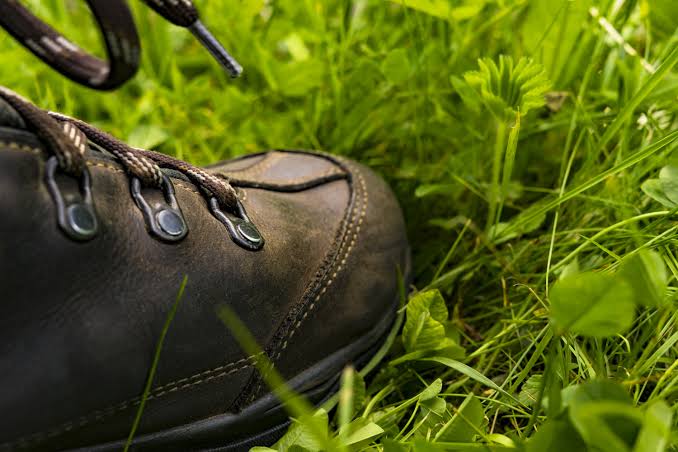Should You Buy Hiking Boots A Size Bigger : Yes or No
Many outdoor enthusiasts suggest opting for a size larger than your regular footwear, but it’s important to clarify that this doesn’t mean acquiring boots that are excessively larger than your feet.

Instead, the idea is to find a pair that allows your toes some freedom of movement within the shoes. Picture this: when you flex your toes up and down, they shouldn’t be uncomfortably pressing against the upper of the boot.
This additional space indeed offers benefits during hiking adventures. It potentially minimizes the risk of blister formation by reducing friction between your feet and the boots, especially on downhill treks.
Should You Buy Hiking Boots A Size Bigger?
Suppose your regular shoe size is a comfortable 9. When contemplating the idea of sizing up, it’s not about leaping to a size that dwarfs your feet; rather, it’s about finding a size that provides a touch more room for your toes to move without constriction.
This notion aligns with the principle that your toes should ideally have space to wiggle and flex, while the rest of your foot remains snugly supported within the boot.
Practical Methods
Here’s a practical way to approach this: Try on a pair of hiking boots in your usual size, in this case, size 9. Pay attention to how your toes feel within the toe box. If they feel a bit compressed or restricted, it might be a sign that a bit more space could be beneficial.
Now, test the hiking boots with a size 9.5. Slip your feet into these boots and take a few steps. Do your toes now feel free to move without any uncomfortable pressure against the front of the boot? If so, this could be the sweet spot for you.

However, it’s worth highlighting that this isn’t a one-size-fits-all rule. Every foot is unique, and the right fit can vary based on factors such as foot width, arch shape, and personal comfort preferences.
If the size 9.5 provides sufficient space for your toes but doesn’t feel excessively roomy, it might be the ideal balance between comfort and support.
Keep in mind that hiking boots, like any footwear, undergo a break-in period. They mold to the shape of your feet over time, providing a customized fit. This means that while you might opt for a slightly roomier boot, it shouldn’t be so large that it poses a stability risk.
If you venture into boots that are significantly larger than what your feet require, you might find your feet sliding within the boots, leading to discomfort and instability on the trail.
Goldilock Zone
In essence, the concept of sizing up hiking boots is about finding that “Goldilocks” zone—a size that’s not too tight, not too loose, but just right. It’s about acknowledging the value of a bit of extra space while staying mindful of the need for a secure and supportive fit.

Your choice of hiking boot size should align with your comfort, the specific demands of the trail, and the particularities of your feet. So, while considering a size bigger can be a wise move, it’s essential to tread carefully and strike a balance that ensures both comfort and performance.
Some Common Things to Remember
Some common things should be remembered after buying shoes.
Breaking In
When you first wear your hiking boots, they might feel a bit stiff or snug. This is entirely normal, as the materials, including the leather or synthetic upper and the cushioning, need time to mold to the contours of your feet.
With each step you take on the trail, the boots gradually adapt to your foot shape, creating a more personalized and comfortable fit.
Room for Socks
The choice of socks is integral to the overall fit of your hiking boots. Hiking-specific socks are designed to provide cushioning, moisture-wicking properties, and support.
These socks will fill up any extra space within the boot, ensuring that your foot doesn’t slide around excessively. This snugness prevents friction and minimizes the risk of blisters caused by rubbing.
Sock Variability
The thickness of socks you wear varies based on the weather conditions and the demands of the trail. Thicker socks are preferred in colder weather for insulation, while thinner socks are more suitable for warmer temperatures to prevent overheating.
The extra space in slightly larger boots accommodates the varying thicknesses of socks, ensuring that your boots remain comfortable regardless of the season.
Foot Swelling
Long hikes, especially those at higher altitudes or during warm weather, can lead to foot swelling. The added space in your boots allows for this natural expansion, reducing pressure on your feet.
This accommodation of foot swelling prevents discomfort and blisters, which can result from the constriction caused by tight-fitting footwear.
Stability Considerations
Although extra space provides comfort, be cautious not to overdo it. Boots that are excessively large can compromise stability on rugged terrain.
Proper support is essential for preventing twisted ankles and maintaining a secure footing, especially when navigating uneven paths or rocky surfaces.
Personal Comfort
Ultimately, the level of comfort you experience with your hiking boots is a matter of personal preference. Some hikers appreciate a snugger fit for better control and a more precise feel of the terrain.
Others prioritize a bit more room to accommodate natural foot movement. Striking the right balance between these preferences ensures that you can confidently tackle the trail with both comfort and control.
Conclusion
Choosing hiking boots that are slightly larger in size entails considering a range of factors. From the gradual breaking-in process to the compatibility with varying sock thicknesses, accommodating foot swelling, and enhancing comfort during downhill sections, each aspect contributes to your overall hiking experience.
The goal is to achieve a harmonious fit that provides both comfort and stability, allowing you to enjoy the great outdoors while minimizing the potential for discomfort or foot-related issues.


